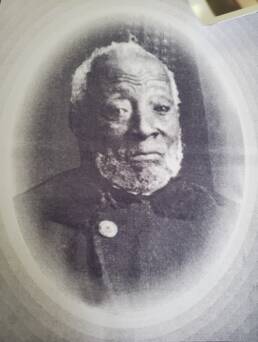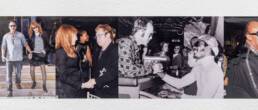From Casa Loma to Port Perry: untangling local history
June 2, 2022 | By Chris Hampton
Every place — no matter how big or small — has a story. Some are well known, while others wait to be told. It’s through culture that we uncover, amplify and celebrate the stories defining who we are, where we are and how we got here. And it’s this kind of work that’s inspired our third Creatives in Residence theme: Local History.
“I think we’ve been revisiting familiar places with new eyes lately,” says Ontario Culture Days Senior Adviser Meaghan Froh Metcalf. Maybe that’s because travel limitations caused us to rediscover treasures in our own backyard, she says, or perhaps because we’ve started to ask questions about our surroundings. “Whose histories are being told and what stories are we privileging?” asks Froh Metcalf. “There’s a lot of richness that’s been forgotten, and through these projects, we’re really hoping to bring some of that to light.”
Today, we meet the creatives telling Ontario’s local stories and examining how those stories are being told.

Uju Umenyi
It started with a 10-minute play, staged during a cemetery walk in 2017, based on the life of Port Perry’s first Black resident, Samuel Stout. The Durham repertory company Theatre on the Ridge, which had produced the vignette, wanted to explore the story deeper. So, the company issued a call for playwrights to enrich the tale of Stout.
When Uju Umenyi learned of the opportunity, “my spirit jumped,” she says. “It was just ‘yes.’” The Scarborough-based actor had been involved with community theatre for years, but she’d never written for the stage, though she’d long wanted to. The story of Stout compelled her to take the leap.
Although the details of his biography were scant, Stout’s life stirred Umenyi’s curiosity. He had come up from the States to Port Perry when he was already in his 50s. He became a prominent figure in community life: he was a prolific multi-instrumentalist who led the town band, as well as a barber.
“What’s the story there?” Umenyi asks. In the middle of the 19th century, he was the only Black man living in this tiny town. “What on earth was that like? What made him stay. When we look at Canadian history, there are so many opportunities to fill in the gaps that we didn’t even know existed,” she says. “That’s the really exciting piece: the opportunity to fill in the gaps we didn’t know were there, the opportunity to share the learning and the opportunity to learn and grow myself.”
Umenyi’s residency will culminate during the 2022 Ontario Culture Days Festival in September with a staged reading of her full script, as well as other programming around Umenyi’s work.
“We are all about helping emerging artists,” says Carey Nicholson, artistic director of Theatre on the Ridge. In supporting a first-time playwright, like Umenyi, they put their money where their mouth is. But what they’re building together is, Nicholson says, “bigger and better and bolder than anything we’d envisioned.”

Dave Dyment
Dave Dyment is a multidisciplinary artist whose work might take the form, he says, of an artist book, a photo series, video, sound work, performance, sculpture or “things” that he might call drawings. “I like to let the medium serve the idea, rather than the other way around.”
His work largely explores popular culture. In a recent exhibition, for example, he strung photographs of famous handshakes in a 100-foot-long daisy chain around the perimeter of Toronto’s postal code MKG 127. It began with Richard Nixon shaking hands with Elvis, then it was Elvis shaking someone else’s hand and so on until it completed the loop with Donald Trump hand-in-hand with Nixon.
Another recent work, Watching Night of the Living Dead, recreated George Romero’s 1968 classic using scenes from other films and TV shows in which characters are watching the seminal zombie flick. “There’s probably 80 to 90 per cent coverage of the original film,” Dyment says, which is a testament to both its massive influence as well as the clerical error that caused it fall out of copyright, enabling it to appear just about anywhere.
His work, he says, is about culture: “how it’s formed, how it’s used.” Dyment paraphrases a quote from art critic Dave Hickey as best as he remembers it: “We don’t make architecture, literature or cinema; we make buildings and books and movies, and then culture assigns value to those things.”
“That’s really interesting to me,” he says, “the way cultural value is assigned.”
For his residency, Dyment is working on a film titled Dead Ringer, composed entirely from TV and movie scenes which were filmed in Toronto, though the scene is not set in Toronto. These are moments, you could say, when the city does not “play itself.” The star of his film is Casa Loma (where it will premiere in September). Paradoxically, the Gothic Revival mansion is a postcard landmark of Toronto, though it’s doubled on screen as any number of settings from around the world. “What does it mean,” Dyment asks, “to see your city reflected back at you, but not your experience of it?”
At the same, he’s interested in the way cinema can function as a kind of archive. “There’ll be scenes of Toronto that are unrecognizable to us now because buildings have gone up or buildings have gone down.” The only record of that old shoe store you may remember, he says, may only be captured with Elisabeth Moss running past carrying a gun.
Although the city rarely plays itself, the camera has covered it extensively; you’ve seen its face a thousand times in a thousand different roles. Dyment’s project suggests that even if it never gets top billing, Toronto is already something of a movie star.
The Creatives in Residence community programs will be open to the public during our festival in September and October 2022.

